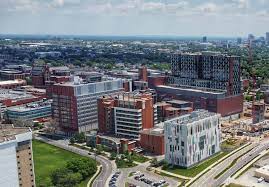The Ohio State University Wexner Medical Center revealed plans for the construction of an adult inpatient rehabilitation hospital. The three-storey facility will be situated on Taylor Avenue in Columbus’ Near East Side. This location is next to the medical center’s Outpatient Care East, close to Ohio State East Hospital.
The new rehab hospital at Ohio State Wexner Medical Center is slated to open in 2025. The facility will focus on the treatment and research of patients with stroke, brain, and spinal cord injuries. The Wexner Medical Center and Louisville will collaborate on the development and operation of the 86,000-square-foot hospital complex. Louisville is a Kentucky-based Kindred Rehabilitation Services that runs more than 30 inpatient rehabilitation centers across 18 states.
Cost, funding, and the start of the construction works
Also Read: Mistakes Not To Make When Hiring A Roofing Contractor In Hudson Ohio
The overall cost of the project has not been calculated and won’t be for several months. This was revealed by Wexner Medical Center leaders who talked to the media during a recent televised news briefing. However according to officials Kindred and the medical center will divide the expense.
Kindred is a division of LifePoint Health that specializes in rehabilitation management and services. Its headquarters is in Brentwood, Tennessee.
According to Dr. Andrew Thomas, a year is about how long it will take for executives to decide exactly when construction workers will start work on the project. Dr. Andrew Thomas is a chief clinical officer at the Wexner Medical Center.
Expectations for the new rehab hospital at Ohio State Wexner Medical Center
The new 80 beds rehab hospital at Ohio State Wexner Medical Center will replace the 60-bed Dodd Rehabilitation Hospital. It would enable the academic health system to enhance access to inpatient rehabilitation treatments in the area by 30%. This is according to Wexner Medical Center administrators.
Wexner leaders also claim that the new hospital will be closer to major transportation arteries. It will therefore provide easier access to patients traveling from around the region for care.

Leave a Reply